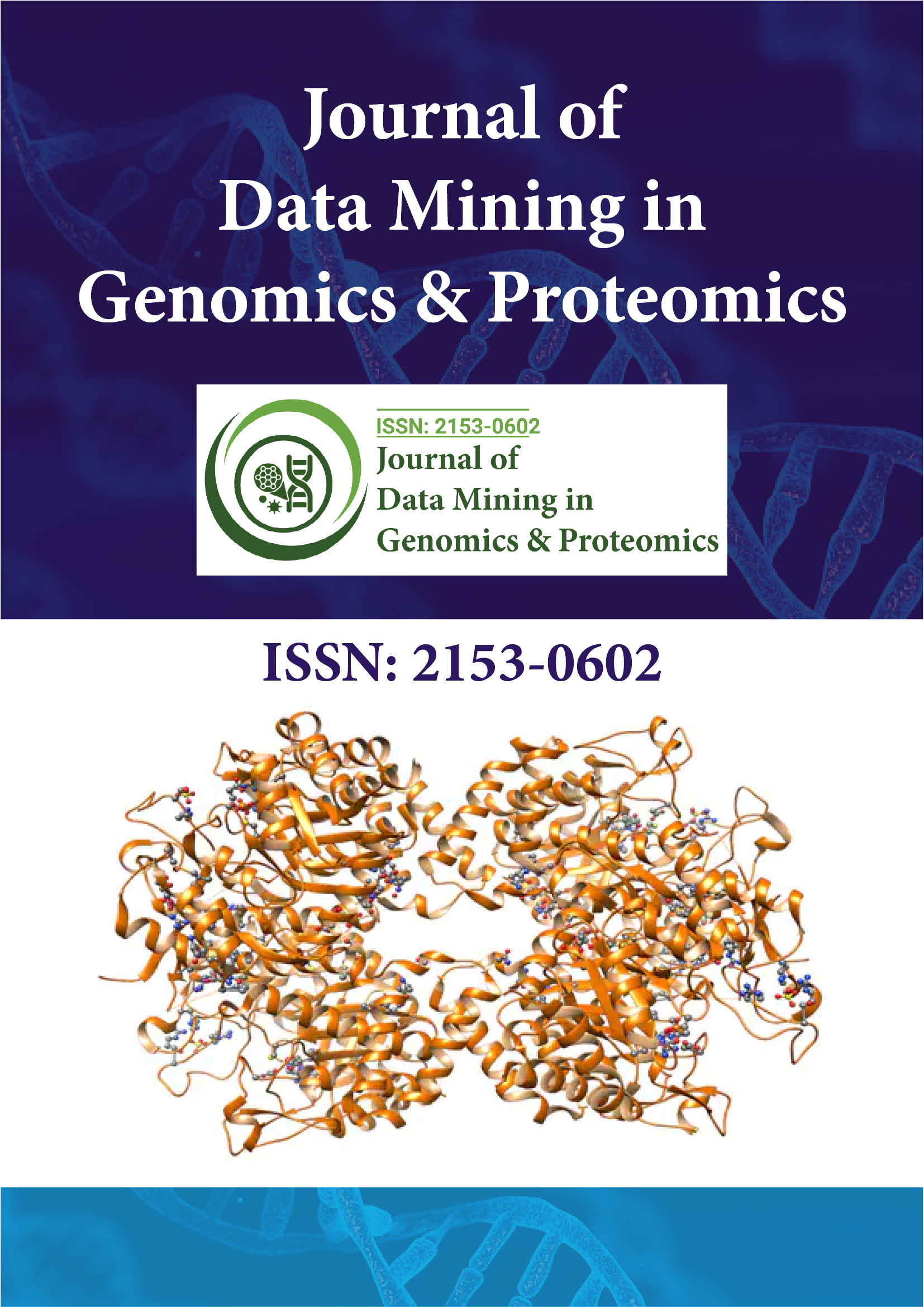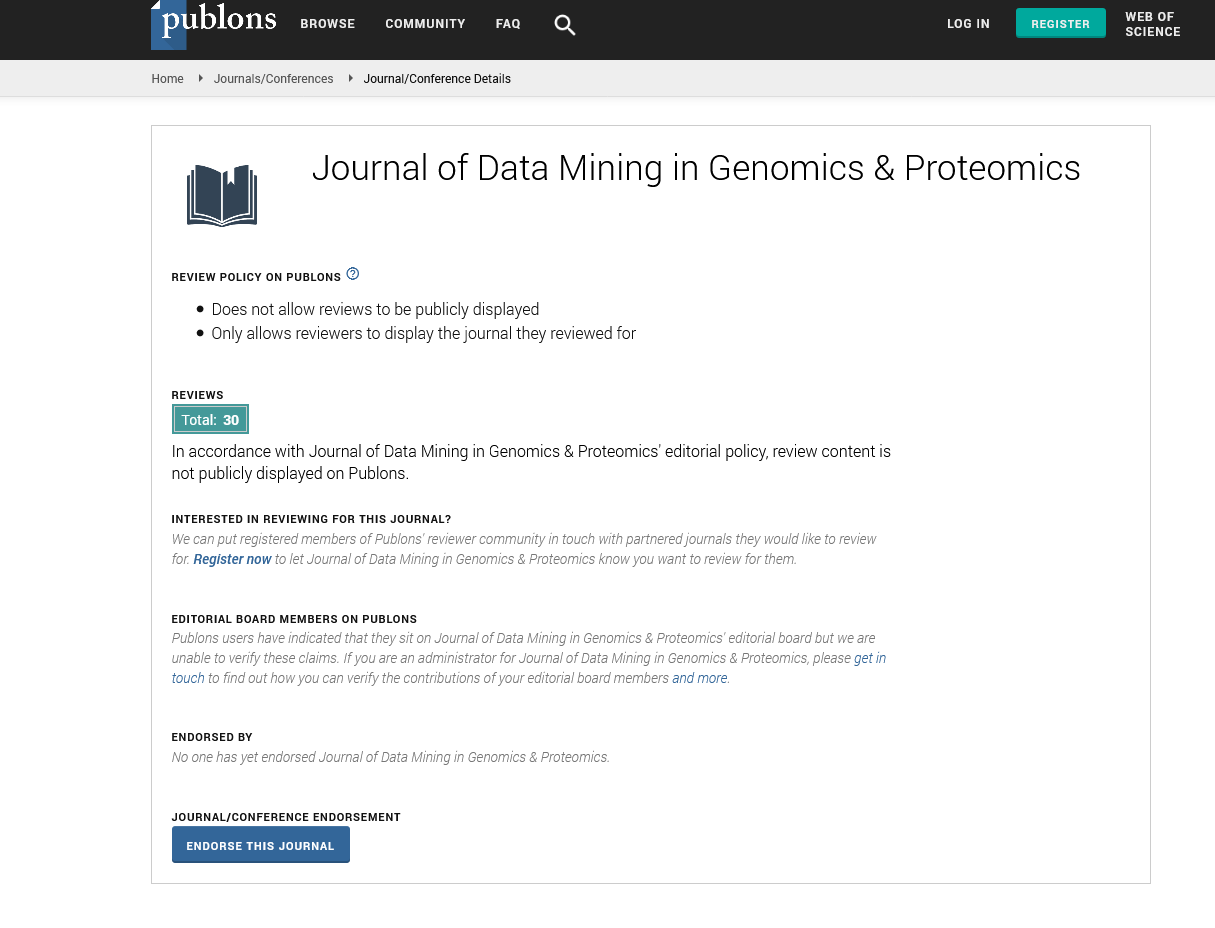Indexed In
- Academic Journals Database
- Open J Gate
- Genamics JournalSeek
- JournalTOCs
- ResearchBible
- Ulrich's Periodicals Directory
- Electronic Journals Library
- RefSeek
- Hamdard University
- EBSCO A-Z
- OCLC- WorldCat
- Scholarsteer
- SWB online catalog
- Virtual Library of Biology (vifabio)
- Publons
- MIAR
- Geneva Foundation for Medical Education and Research
- Euro Pub
- Google Scholar
Useful Links
Share This Page
Journal Flyer

Open Access Journals
- Agri and Aquaculture
- Biochemistry
- Bioinformatics & Systems Biology
- Business & Management
- Chemistry
- Clinical Sciences
- Engineering
- Food & Nutrition
- General Science
- Genetics & Molecular Biology
- Immunology & Microbiology
- Medical Sciences
- Neuroscience & Psychology
- Nursing & Health Care
- Pharmaceutical Sciences
Perspective - (2025) Volume 16, Issue 2
Multi-Omics Integration in Cancer Research Using Data Mining
Anna Mueller*Received: 29-May-2025, Manuscript No. JDMGP -25-29766; Editor assigned: 31-May-2025, Pre QC No. JDMGP -25-29766; Reviewed: 14-Jun-2025, QC No. JDMGP -25-29766; Revised: 20-Jun-2025, Manuscript No. JDMGP -25-29766; Published: 28-Jun-2025, DOI: 10.35248/2153-0602.25.16.385
Description
Cancer is a complex and highly diverse disease influenced by a combination of genetic, epigenetic and environmental factors. Traditional research approaches that focus on a single biological layer such as genomics alone have provided important insights, yet often fall short in capturing the full intricacies of tumor biology. To address this limitation, the scientific community is increasingly turning to multi-omics integration, which involves combining various biological datasets to build a more holistic understanding of cancer. Data mining techniques are essential in this process, enabling researchers to extract meaningful patterns from high-dimensional and heterogeneous datasets that can guide clinical decision-making.
Genomic sequencing remains a foundational tool in cancer research. It identifies mutations, copy number variations and structural genomic rearrangements that can drive tumor development. However, understanding the functional consequences of these genetic changes requires insight into downstream biological processes. Transcriptomic complements genomics by measuring gene expression levels and identifying dysregulated genes and pathways. Similarly, proteomics examines protein abundance and modifications, offering information about active signaling networks within cancer cells. Metabolomics further enriches this view by capturing shifts in cellular metabolism—an emerging hallmark of many cancer types. Epigenomic, which investigates modifications to DNA and histones, adds another layer by revealing how gene expression is regulated beyond sequence changes. By integrating these data types, researchers can trace a comprehensive path from genetic alteration to cellular phenotype.
One of the major benefits of multi-omics analysis is its ability to identify molecular subtypes of cancer. For instance, breast cancer has been subdivided into multiple clinically relevant groups based on integrated genomic and transcriptomic profiles. These molecular classifications are more precise than traditional histopathological categories and have led to the development of more personalized and effective treatment regimens. Computational methods such as clustering, principal component analysis and network-based models are widely used to uncover hidden patterns in complex multi-omics data, leading to deeper biological insights and improved disease stratification.
Beyond classification, multi-omics integration significantly enhances biomarker discovery. Cancer biomarkers are crucial for predicting treatment responses, monitoring disease progression and assessing prognosis. Single-omics biomarkers often lack reproducibility due to tumor heterogeneity. However, combining data from genomics, proteomics and metabolomics can produce more robust and clinically actionable biomarkers. For example, genetic mutations that influence protein expression can reveal protein biomarkers that are directly linked to oncogenic mechanisms. These integrative biomarkers are currently being used in precision oncology to tailor treatment plans to the unique molecular profile of each patient.
Another promising area of application is understanding and overcoming drug resistance. Resistance to chemotherapy and targeted therapies is a major hurdle in cancer treatment, often leading to relapse. Multi-omics analysis helps identify the genetic and signaling changes associated with resistance, offering clues for new therapeutic interventions. Studies in lung cancer, for instance, have utilized integrated omics to map resistance pathways to EGFR inhibitors, leading to the identification of potential combination therapies that may restore sensitivity or bypass resistance mechanisms.
While multi-omics approaches offer great promise, they also present numerous challenges. These datasets are typically large, complex and generated from various platforms, introducing inconsistencies and batch effects. Missing data, variable quality and differences in sample preparation methods can obscure true biological signals. To address these issues, sophisticated data mining algorithms are required—often incorporating normalization, feature selection, imputation and ensemble learning techniques. Moreover, for clinical applications, findings must be validated in independent cohorts and carefully correlated with patient metadata, including age, gender, treatment history and lifestyle factors.
The integration of multi-omics data also demands robust computational infrastructure. High-performance computing environments, cloud-based platforms and scalable bioinformatics pipelines are essential to manage and process the large-scale data involved. Increasingly, advanced machine learning and deep learning models are being employed to interpret complex, nonlinear relationships within and between omics layers. These models are helping bridge the gap between research and real-world clinical practice by providing predictive tools that support diagnosis, risk assessment and therapeutic planning.
Looking to the future, multi-omics integration is set to become even more powerful with the rise of single-cell and spatial omics technologies. These next-generation techniques enable researchers to investigate the tumor microenvironment with unprecedented granularity, offering insights into tumor-immune interactions, spatial heterogeneity and cell-specific responses to treatment. When combined with artificial intelligence, these approaches promise to further enhance predictive accuracy and lead to truly individualized cancer care.
In summary, the application of data mining to multi-omics cancer research has revolutionized our understanding of tumor complexity. By integrating multiple biological layers—genomic, transcriptomic, proteomic, metabolomic and epigenomic—researchers can discover novel cancer subtypes, identify reliable biomarkers and uncover mechanisms of drug resistance. Although technical and computational challenges remain, ongoing advancements in algorithms, data infrastructure and collaborative research are rapidly propelling the field forward. Ultimately, multi-omics integration is a cornerstone of modern cancer research, bringing the goal of personalized, precision oncology ever closer to reality.
Citation: Mueller A (2025). Multi-Omics Integration in Cancer Research Using Data Mining. Journal of Data Mining in Genomics & Proteomics. 16:385.
Copyright: © 2025 Muller A. This is an open-access article distributed under the terms of the Creative Commons Attribution License, which permits unrestricted use, distribution and reproduction in any medium, provided the original author and source are credited.

